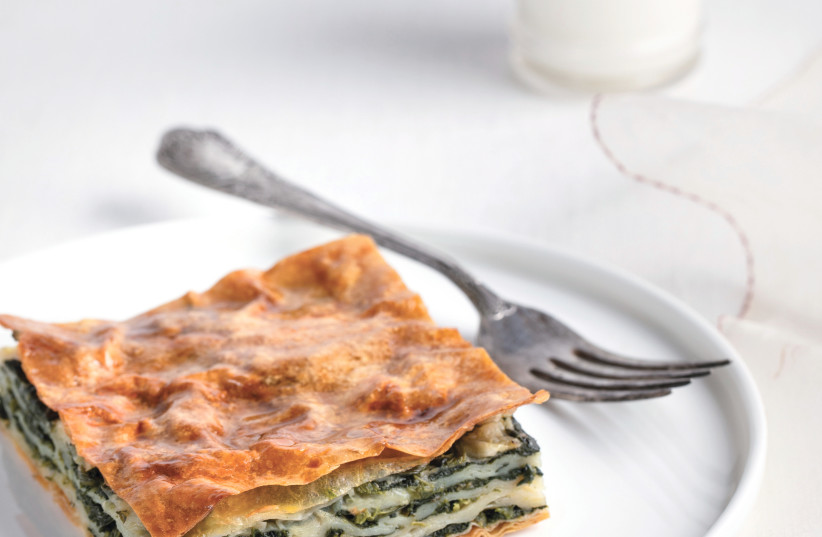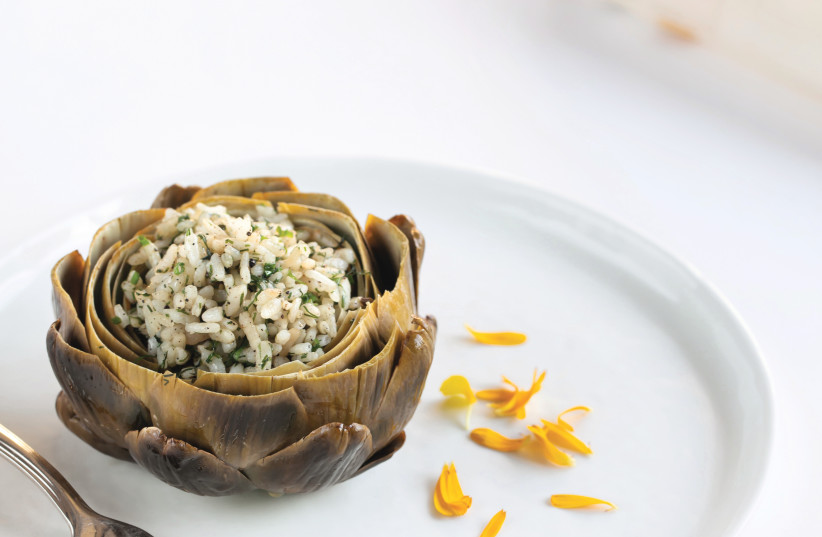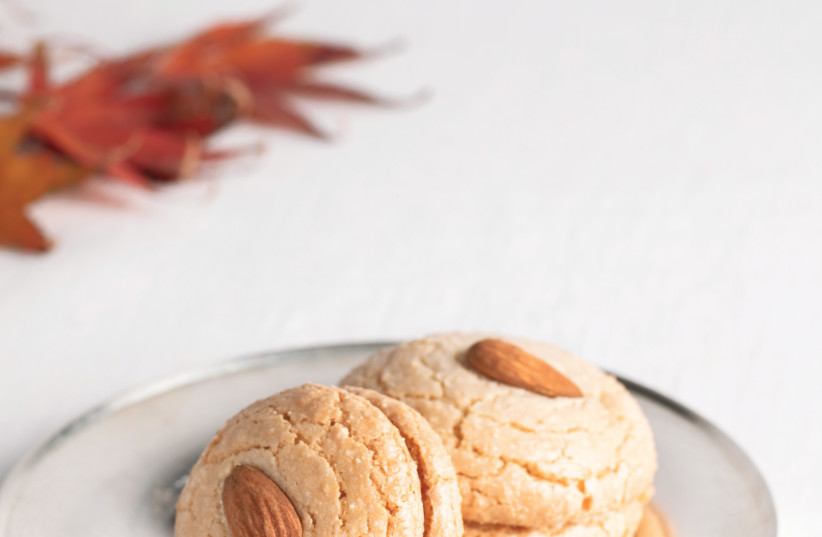Anyone who loves the exceptional flavors found in traditional Turkish cuisine knows that it is characterized by the richness of its ingredients. The main dishes are often made with a variety of vegetables, while the savory and sweet pastries are packed with almonds, semolina and dry bread to soak up the syrup.
Most Turkish dishes are seasoned with just a little bit of salt and pepper. Sometimes a little paprika or turmeric are added, mainly just to add a little color.
I recently came across the Turkish Cuisine with Timeless Recipes cookbook, published by the Turkish Ministry of Culture and Tourism, with the support of the president’s wife, Emine Erdogan. The cookbook’s recipes are taken from traditional Turkish cuisine, but have been tweaked for the more health-conscious, modern world, and aim to abide by zero-waste standards, without compromising flavor and quality.
Below, you will find four recipes from the cookbook.

Tepsi Böregi (Layered Pastry with Spinach)
Tray börek, or tepsi böregi in Turkish, is the most frequently made, most popular homemade börek. Although this börek is better with homemade yufka (thin sheets of dough similar to phyllo dough), it can also be made with ready-made yufka from the grocery store or a yufka shop. This börek can be made with a filling of cheese or minced meat, and also with vegetables like spinach and zucchini. A mixture of plenty of milk, butter and eggs brushed between all the layers makes the börek softer. An important tip to prevent a doughy texture is to create gaps by rumpling the yufkas when placing them in the tray, before adding the milk, egg and oil mixture.
Use a 25 cm. diameter pan.
For the savory börek filling:
- 500 gr. fresh spinach, rinsed and coarsely chopped
- 1 medium onion, finely chopped
- 15 ml. olive oil
- ½ tsp. salt
- ½ tsp. black pepper
- To moisten the yufka sheets:
- 1 egg, beaten
- 100 ml. milk
- 60 gr. melted butter or olive oil
Base:
- 3 fresh yufkas
For top:
- 1 egg yolk, beaten
- Sauté the onions in olive oil. Add spinach, salt and black pepper and sauté for another 2-3 minutes and set aside.
- Mix the egg, milk and butter or oil for moistening the yufkas and set aside.
- Preheat the oven to 200°. Brush the oven tray with the egg, milk and oil mixture.
- Place the first sheet of yufka flat on the tray allowing the excess to hang over the sides. Gently and liberally moisten the dough with the egg, milk and oil mixture.
- Arrange half of the second yufka in a rumpled fashion over the first yufka and moisten with the egg mixture. Repeat with the other yufka half.
- Distribute the spinach filling evenly over the yufkas.
- Arrange the last yufka in the same way, brushing with the egg mixture in between.
- Cover the last layer with the yufka hanging over the tray. Using a basting brush, coat the top of the sides of the börek with the egg yolk.
- Place the börek dish in the middle shelf of the oven and bake for about 25 minutes until golden brown.
Chef’s Note:
The yufkas should be slightly rumpled when layering them in the baking tray so that they don’t stick to one another, and this also allows the börek to puff up more when cooked.

Enginar Dolmasi (Rice and Herb Stuffed Artichokes)
Generally, only the heart of the artichoke is cooked in Turkish cuisine, but when making stuffed artichoke the petals are also used. In this way, the filling, which consists of rice, plenty of scallions and herbs, absorbs the liquid and all the flavor of the vegetable. Picking off the leaves and dipping them in the juices of a dish or yogurt is extremely tasty. This is a flavor unique to Aegean cuisine. In accordance with a zero-waste concept, the edible meaty part of artichoke stems are finely chopped and added to the ingredients used for dolma fillings.
Makes 6 servings.
- 6 large Urla sakız bell artichokes
- 2 lemons
- 15 gr. all-purpose flour
- 6 sprigs of fresh mint, finely chopped
- 6 scallions, finely chopped
- 90 gr. white rice
- 1 bunch of dill, finely chopped
- 1 tsp. salt
- ½ tsp. black pepper
- 1 tsp. sugar
- 120 ml. olive oil
- 1 ¼ cups water
- With a sharp knife, cut the tops off the artichokes 2/3 down from the top. Remove the stem at the base under the leaves.
- Remove and discard the tough outer leaves. Open the center of the artichokes, scoop out and discard the fuzzy part.
- Rub the artichokes with lemon and place in a bowl with water, lemon juice and flour.
- Mix the scallions, dill, mint, rice, ½ teaspoon salt, black pepper and sugar in a bowl.
- Remove the artichokes from the water and stuff the centers with the filling.
- Place the artichokes in a saucepan and add 75 ml. olive oil, the juice of half a lemon, ½ teaspoon salt and water. Simmer over a medium heat for 30 minutes.
- Remove from the burner, pour the remaining olive oil over the artichokes and serve lukewarm.
Chef’s Note:
The artichokes used for stuffed artichokes must be fresh. While the Sakız artichoke is a favorite in and around Izmir, the wide-bottomed Bayrampasa artichoke can also be used when fresh.
Level of difficulty: Medium.
Time: 50 minutes.
Status: Parve.

Acibadem Kurabiyesi (Bitter Almond Cookies)
Acibadem cookies can be referred to as the ancestor of the French macaron, which is very popular today worldwide. On the other hand, it also resembles the bitter almond taste of Italian amaretti biscuits. These cookies, which are made with almonds beaten into flour, egg whites and sugar, are crispy on the outside and soft on the inside. For a more intense, bitter almond taste, the more bitter almonds can be used to make these cookies.
Makes 6 servings.
- 125 gr. sweet Datça almonds
- 20 gr. bitter almonds
- 200 gr. confectioners’ sugar
- 3 egg whites
Topping:
- Sweet almonds
- Bring enough water to the boil to cover the sweet and bitter almonds. Then drain and leave to rest.
- After removing the skins, grind in a food processor until the almonds are like powder.
- In a small saucepan mix the ground almonds, confectioners’ sugar and 3 egg whites well with a wooden spatula.
- Increase the heat. Briskly stir making sure the almond mixture does not stick to the bottom of the pan, simmer until it is too hot to touch.
- Remove from the heat and pour the mixture into a wide dish or a flat marble surface. Leave to completely cool.
- Fill the almond mixture into a piping bag with a wide nozzle and pipe 3 cm. circles 2 cm. apart on a baking sheet covered with greaseproof paper.
- Top each cookie with one almond.
- Place the baking tray in a preheated medium hot oven, then reduce the heat by half and bake for 40 minutes.
- Remove from the oven and serve when cooled.
Chef’s Note:
The oven door should not be opened for 20 minutes after the tray is put into the oven.
Level of difficulty: Medium.
Time: 1 hour.
Status: Parve.
Un Kurabiyesi (Flour and Butter Cookies)
In many parts of Anatolia and the Balkans, there are white cookies made with flour, sugar and butter, which are baked on special occasions, made for engagements or distributed on festive occasions. At one time, when it was hard to find good butter, white sugar and white flour, cookies made from the combination of this trio and pleasantly shaped were greatly valued. Un kurabiyesi (flour cookies) can be classified as a continuation of this tradition. These are a classic taste in patisseries and bakeries.
Makes 6 servings.
- 250 gr. butter or clarified butter
- 200 gr. confectioners’ sugar
- ½ tsp. vanilla extract
- 500 gr. all-purpose flour
- Incorporate the butter, confectioners’ sugar and extract carefully by hand for 3-4 minutes on a marble surface.
- Add the flour and knead for 8-10 minutes with your palm until the mixture no longer sticks to your hand. Scrape the dough from your hands using a spatula, and combine all the dough.
- Divide the dough into walnut-sized pieces and roll them on the palm of your hand. Shape like a cookie by gently pressing and place them on a baking sheet.
- Place in the bottom of a preheated 150° oven and bake for 15-20 minutes making sure they don’t brown but remain white. Leave to rest, then serve.
Chef’s Note:
These cookies must be white. In order to bake them white, the heat must be low. If necessary, the oven door can be left open.
Level of difficulty: Easy.
Time: 30-40 minutes.
Status: Dairy.
Translated by Hannah Hochner.
